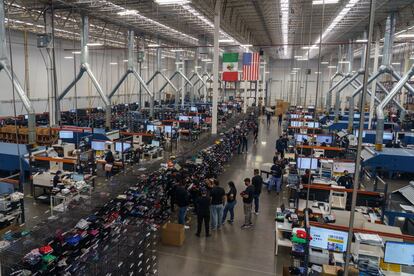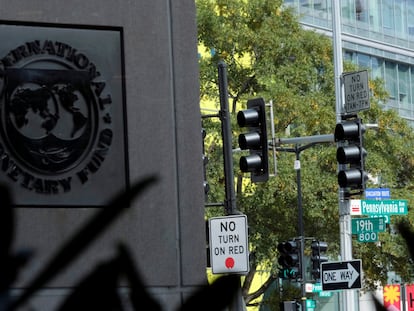Mexico surpasses China as main exporter to the US for first time since 2002
Official data published on Wednesday confirm America’s ongoing efforts to decouple its economy from the Asian giant’s as well as Mexico’s push towards nearshoring

The United States imported more goods and services from Mexico than from any other country in the world in 2023, displacing China for the first time in 21 years, according to data released by the U.S. Census Bureau on Wednesday. Mexican exports to its neighbor totaled $475.6 billion, a jump of 4.6% compared to 2022. Meanwhile, China sold 20% less to America in 2023 compared to the previous year. Imports from China totaled $427.2 billion.
The share of Chinese products in total U.S. imports also fell: they stood at 13.9% in 2023, the lowest level since 2004. In 2022, they had reached 16.3%. There are two factors behind this reconfiguration of trade: first, an effort by the United States to “decouple” its economy from China’s, a movement that began in the era of Donald Trump. Second, an effort by Mexico to fill that void through the tools offered by the USMCA trade agreement, to promote the country as a destination for companies wishing to leave China. The most recent data consolidates Mexico as the main trading partner of the United States.
“Reshoring is definitely changing trade,” said Nada Sanders, a professor of supply chain management at Northwestern University in Boston. “For the first time in decades, Mexico has surpassed China as the leading source of imported goods. According to the latest data, which I’ve just had access to, Mexico is filling the gap and slowly growing. China’s share of global goods exports has declined in the United States. Besides Mexico, the gap is largely being filled by India, followed by Vietnam, Poland, Indonesia and then Romania. Mexico continues to be an important component.”
In the peak year of 2017, that proportion had reached 21.6%, the highest since records began. Those were different times: the United States and China maintained a political rivalry but were aware of their mutual economic dependence. The U.S. recovery after the 2008 financial crisis and the explosion of growth in the Asian country triggered trade exchange.
But the trade war unleashed during Trump’s presidency began to slow that trend. Both countries raised their mutual tariffs. The growing geopolitical and economic rivalry moved to the realm of technology. The era of the so-called “decoupling” began, the separation of its technological sectors. So did mutual distrust.
The outbreak of the Covid pandemic altered that trend: in 2020 and 2021, Americans rushed to buy all kinds of products made in China. Computers, office goods for teleworking, television sets, toys, bicycles. In 2022, with the worst of the outbreak over, it was the complications and delays in global supply chains that kept the numbers rising: once the bottlenecks at the ports were resolved, which had prevented the replenishment of products, U.S. companies began buying goods to shore up their stocks. They did this to such an extent that in 2023 they were still sufficiently full and orders were reduced.
The 2023 data now points to a return to the Trump era trend. Neither country has withdrawn their tariffs. Distrust between the two governments is still present, despite small steps to stabilize the relationship. Among them, the face-to-face meeting between the respective presidents, Joe Biden and Xi Jinping, outside San Francisco during the APEC summit in November last year. Meanwhile, since 2018 some companies have moved their production from China to neighboring countries such as Vietnam, or else to Mexico.
In Mexico, a promising narrative has been established around nearshoring, although analysts have expressed concern about whether the country has the necessary infrastructure in terms of water supply, electricity, and road safety to take advantage of this window of opportunity. Sanders believes that perception is changing. “The current opinion among companies in Mexico is that they can indeed grow and they will. There is a definite change in sentiment within Mexico in terms of what they can and will do. This sentiment is a significant change and the country is taking the momentum to fill the void and lead in this space.”
Sign up for our weekly newsletter to get more English-language news coverage from EL PAÍS USA Edition
Tu suscripción se está usando en otro dispositivo
¿Quieres añadir otro usuario a tu suscripción?
Si continúas leyendo en este dispositivo, no se podrá leer en el otro.
FlechaTu suscripción se está usando en otro dispositivo y solo puedes acceder a EL PAÍS desde un dispositivo a la vez.
Si quieres compartir tu cuenta, cambia tu suscripción a la modalidad Premium, así podrás añadir otro usuario. Cada uno accederá con su propia cuenta de email, lo que os permitirá personalizar vuestra experiencia en EL PAÍS.
¿Tienes una suscripción de empresa? Accede aquí para contratar más cuentas.
En el caso de no saber quién está usando tu cuenta, te recomendamos cambiar tu contraseña aquí.
Si decides continuar compartiendo tu cuenta, este mensaje se mostrará en tu dispositivo y en el de la otra persona que está usando tu cuenta de forma indefinida, afectando a tu experiencia de lectura. Puedes consultar aquí los términos y condiciones de la suscripción digital.










































